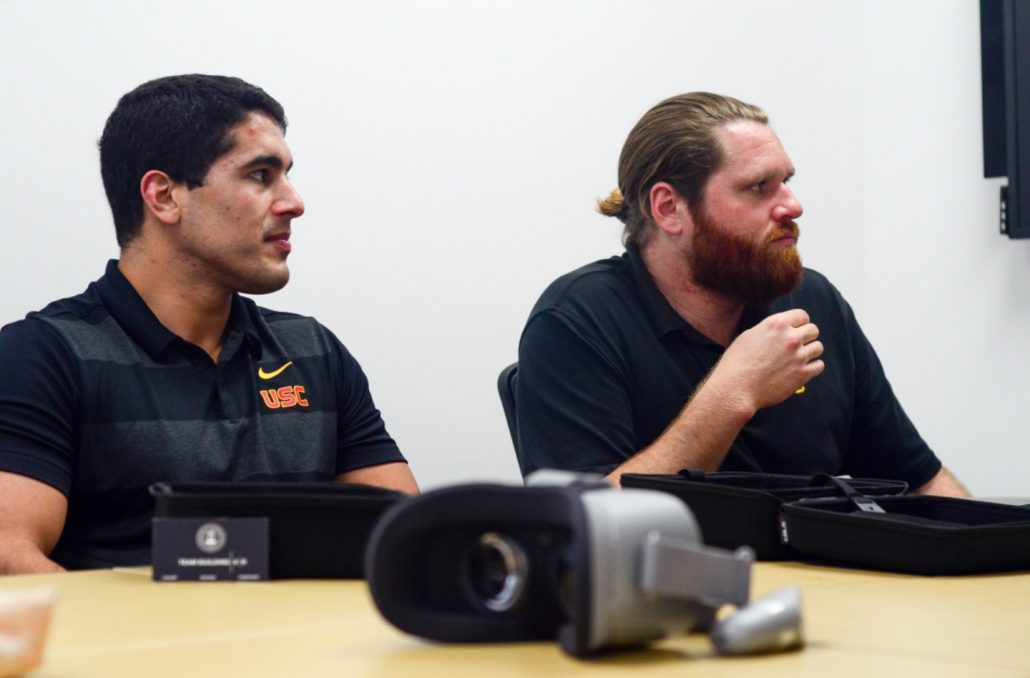Marshall to pilot virtual reality bias training

Unconscious bias in the hiring process is alive and well, a recent study published in the Proceedings of the National Academy of Sciences found. The report showed that since 1990, white job applicants receive 36 percent more callbacks than black applicants and 24 percent more than Latinx applicants. The Marshall School of Business is hoping to change that — with the help of virtual reality.
As part of USC’s 2019 Diversity, Equity and Inclusion week, Marshall hosted an event Wednesday called “Exploring Unconscious Bias — A Virtual Reality Exercise.” Presented by Team Building | VR, a VR training and development program, the event detailed a new bias training program that Marshall hopes to pilot this summer in its Experiential Learning Center.
Assistant Marshall Dean Gita Govahi said VR is essential in educating people about their unconscious biases because it makes the subject less “threatening.”
“If I sit you down and say, ‘Let’s talk about your unconscious bias,’ it’s already in the conscious level, so it’s a waste of time,” Govahi said. “So I have to come up with a back door … it seemed natural to look at virtual reality as a way to explore unconscious bias.”
The program that the company is currently developing with the center puts users in a scenario in which they are responsible for choosing the best candidate for a job. The exercise will begin with students reading and ranking five applications. Then, students put on the VR headset to complete a 20-minute hiring process, including video interviews with the candidates, who will be played by actors.
Miles Suleman, chief operating officer of Team Building | VR, said one of the goals of the VR experience is to evoke emotion from users.
“Having the emotional connection to why [unconscious bias] is wrong and having that near first-hand experience is a very good tool for driving behavior,” Suleman said. “What we wanted to do is create a narrative that created [emotional] investment for the student in the exercise.”
After students select the candidate they believe is best for the job, two “higher-ups” take on the task of further evaluating the selected candidate. The student will observe the conversation, which will be tailored to include biased comments — for example, criticizing an applicant’s tattoos.
In every scenario, the candidate the student selects ultimately will not be picked for the job. In the final portion of the exercise, students sit in the selected candidate’s car while he or she is rejected over the phone.
“The scenario is going to reject every single [candidate], just to show you someone else’s biases,” Govahi said.
Suleman said the experience has been designed to invite open conversation without making students defensive about the implicit biases they may have.
“When things like this happen to you, you don’t necessarily want to have a discussion about it,” Suleman said. “But when you are invested with someone and watch it happen, you have the ability to talk about why you think it’s wrong.”
The presenters said retention levels can be as high as 80 percent one year after a VR experience. Rob McCarty, CEO of Team Building | VR, said the technology is ideal for education and training because it allows users to fail and try again without real-life repercussions.
“Simulating an experience comes down to really hijacking all of the senses to really create a sense of presence in the brain,” McCarty said. “This sense of presence is where memories can be formed, experiences can be had and emotions can be provoked . . . We were going fully into the deep end.”
McCarty and Suleman spoke of other ways virtual reality is used in order to create social change. The United Nations’ Virtual Reality program, use immersive storytelling to encourage empathy and positive social change.
Govahi said the VR experience is not meant to test users for a right or wrong answer.
“Bias is nothing more than recognition or relating to patterns that are familiar to you,” Govahi said. “Our job with this exercise is [to] put you in touch with the patterns that you are familiar with. Then you’re the judge of what aspect or component of your perception and future behavior you’re going to change.”

